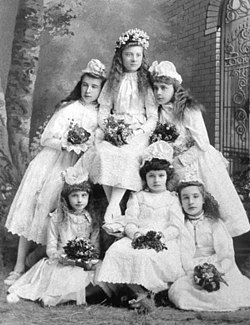YOU must wake and call me early, call me early,
mother dear;
To-morrow 'll be the happiest time of all the glad
new-year, -
Of all the glad new-year, mother, the maddest,
merriest day;
For I'm to be Queen o' the May, mother, I'm to
be Queen o' the May.
I sleep so sound all night, mother, that I shall
never wake,
If you do not call me loud when the day begins
to break;
But I must gather knots of flowers and buds,
and garlands gay;
For I'm to be Queen o' the May, mother, I'm to
be Queen o' the May.
Little Effie shall go with me to-morrow to the
green,
And you'll be there, too, mother, to see me made
the Queen;
For the shepherd lads on every side 'll come from
far away;
And I'm to be Queen o' the May, mother, I'm to
be Queen o' the May.
The night-winds come and go, mother, upon the
meadow-grass,
And the happy stars above them seem to brighten
as they pass;
There will not be a drop of rain the whole of the
livelong day;
And I'm to be Queen o' the May, mother, I'm to
be Queen o' the May.
All the valley, mother, 'll be fresh and green and
still,
And the cowslip and the crowfoot are over all the
hill,
And the rivulet in the flowery dale 'll merrily
glance and play,
For I'm to be Queen o' the May, mother, I'm to
be Queen o' the May.


